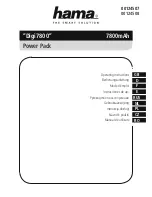
14
Overvoltage protection (OVP) is fully variable within the range 1V to 66V. The OVP limit
is set via the screwdriver adjustable OVP preset potentiometer, accessible through a
hole in the front panel immediately above the OVP key. Rotating the preset clockwise
increases the limit, which can be read directly on the user display by pressing the OVP
key beneath the preset. If the voltage on the output exceeds the set OVP for any
reason, including an externally forced voltage, the output will be tripped off.
It should be noted that the unit can only source current and cannot sink it, thus units cannot be
series connected in anti-phase.
The unit can be connected in parallel with others to produce higher currents. Where several units
are connected in parallel, the output voltage will be equal to that of the unit with the highest output
voltage setting until the current drawn exceeds its current limit setting, upon which the output will
fall to that of the next highest setting, and so on. In constant current mode, units can be connected
in parallel to provide a current equal to the sum of the current limit settings. For optimum operation
connect the power supplies separately to the load
.
Note that the output terminals are rated at 30A maximum; if two or more outputs are operated in
parallel to source higher currents than this the junction should be made at a separate point, not
one of the terminals.
Protection
Over-current protection (OCP) is implemented in firmware and can only be set and used when
under remote control via the RS232, USB, LAN (LXI) or GPIB interfaces (CPX400DP only).
Setting resolution is 10mA and typical response times are 500ms. In local mode and for
CPX400D, OCP is still active but automatically defaults to 22 Amps.
When the output is tripped the displays will show
OUP triP
and the OUTPUT lamp will flash.
Turn the output off; the trip message should be replaced with the normal preset V and I readings.
When the cause of the trip has been removed the output can be switched on again.
Even with the output off the load is still connected to the power supply output stage.
Do not apply
external voltages in excess of 70V to the power supply terminals or damage may result.
The output is protected from reverse voltages by a diode; the continuous reverse current must not
exceed 3 Amps, although transients can be much higher.
Over-temperature Protection
Sensors on both the secondary heatsinks will detect over-temperature due to blocked air-flow, fan
failure or other circuit fault. Over-temperature will turn the output off, the OUTPUT indicator will
flash, and the display will show the message
OtP trip
.
The output will remain shut down
even after the heatsinks have cooled down. When the cause of the over-temperature has been
removed and the heatsinks have cooled to normal working temperatures the output can be reset
by turning the POWER switch to standby (
) then on (
l
) again.
If either output temperature trips when the instrument is operating in independent mode then the
other output will continue to operate normally.
If, however, the instrument is operating in Tracking mode then a temperature trip on either output
will turn both outputs off;
OtP trip
will show only in the display of the output which caused the
trip.
In addition, there is an ambient temperature sensor near the PFC (power factor correction) stage
on the Main PCB. If this detects an over-temperature problem, all power circuits will shut down and
the display will go off (no
OtP trip
message is shown); however, as soon as the ambient
temperature cools, the instrument will restart. If the outputs had been ON at the time of the over-
temperature shut-down, and the output state at power-on had been set to ‘same as at last power-
off’ (see Switching On section), the outputs will come on again, raising the ambient temperature
again if the fault is still present. The instrument will continue this power-up, power-down cycle until
the cause of the over-temperature problem is rectified.
Содержание CPX400D
Страница 1: ...CPX400D DP PowerFlex Dual DC Power Supply ...
Страница 34: ...Book Part No 48511 1480 Issue 10 ...
















































